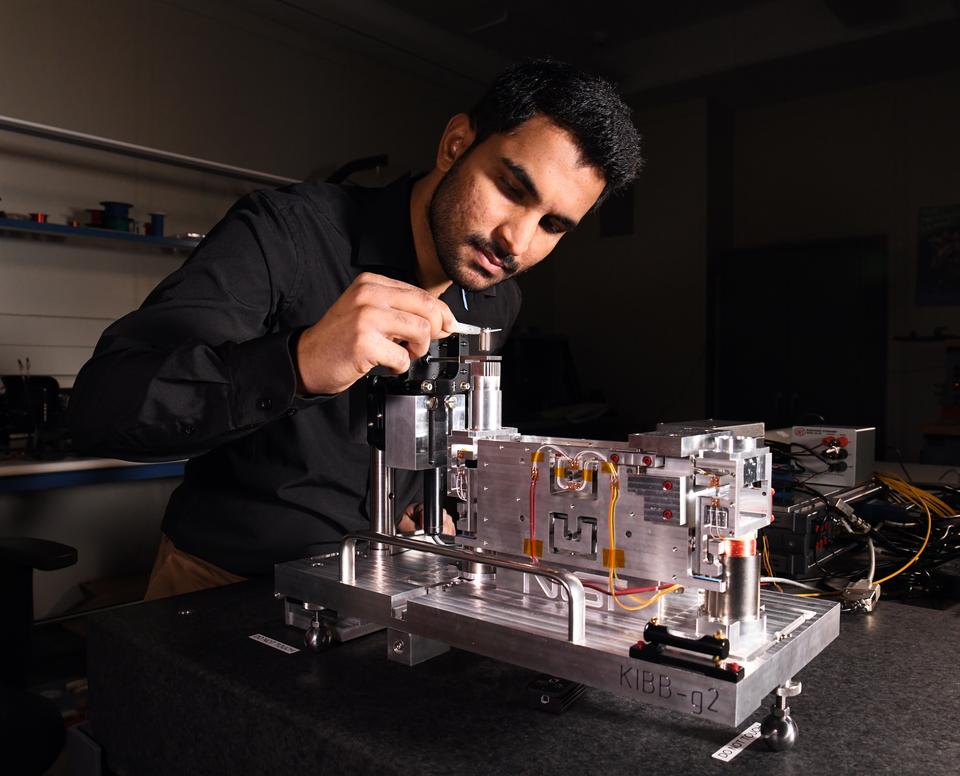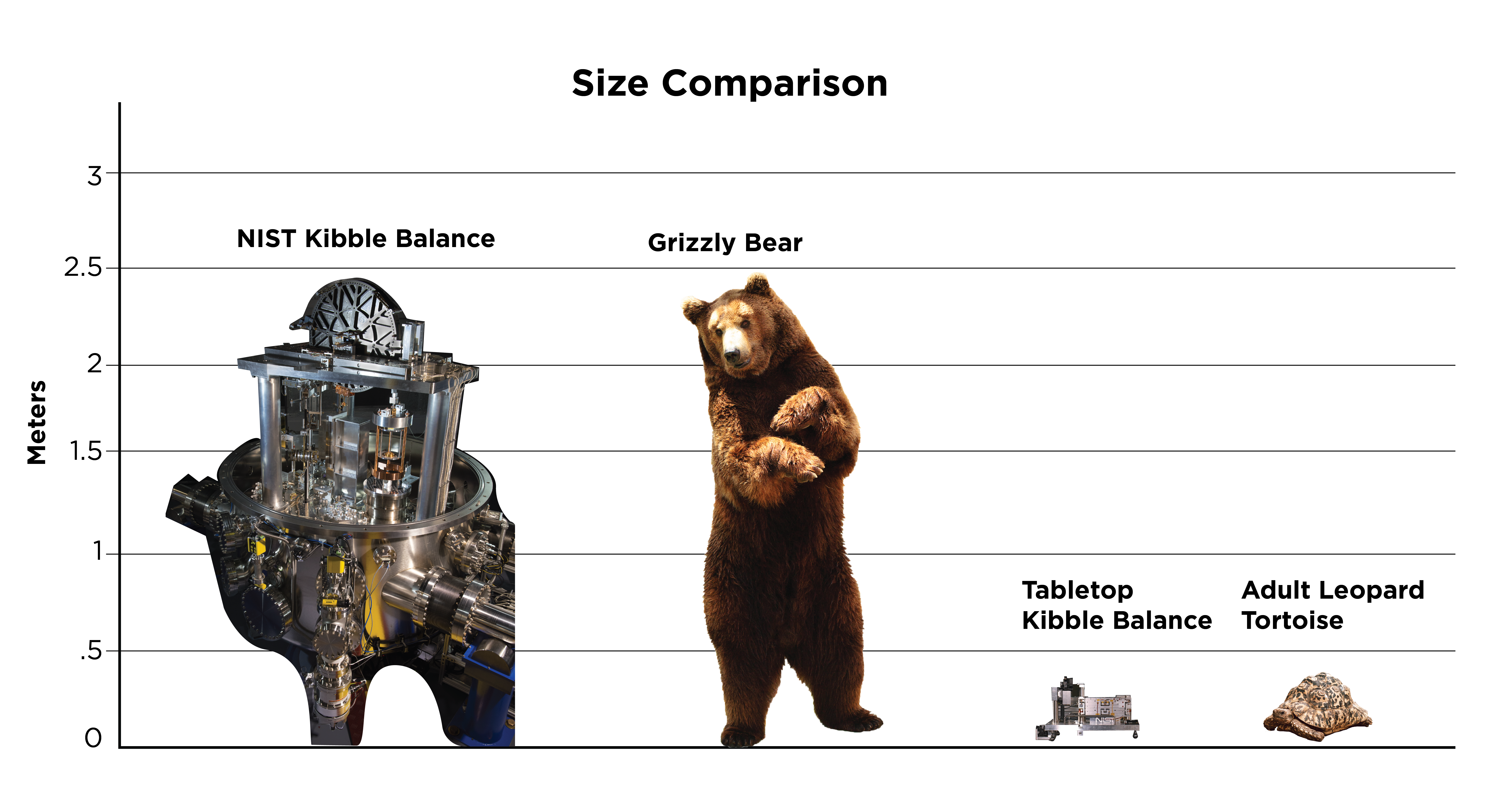- NIST has delivered a portable and highly accurate instrument for measuring mass to the U.S. Army, marking the first time in the U.S. that this technology is available outside of NIST.
- The instrument eliminates the need for the Army to send equipment to NIST for costly and lengthy mass measurements.
- NIST has also partnered with Snap-on Inc. to create an affordable and user-friendly tabletop system that can calibrate torque wrenches, which has been a long-standing, costly issue for industry.

NIST engineer Kumar Arumugam examines the tabletop Kibble balance before its delivery to the U.S. Army.
Bringing its cutting-edge invention to the larger world for the first time, the National Institute of Standards and Technology (NIST) has delivered a portable and superaccurate tabletop instrument for measuring mass to the U.S. Army, potentially revolutionizing critical measurements in a variety of applications, from weighing aircraft components to delivering exact doses of medicine.
NIST delivered the mass measurement instrument, known as a tabletop Kibble balance, to the U.S. Army Redstone Arsenal near Huntsville, Alabama, in early April. This marks the first time in the U.S. that a tabletop Kibble balance has been put into use outside of NIST.
“This is the first Kibble balance that is out in the wild,” said Stephan Schlamminger, NIST physicist. “The Army are good early adopters of this technology because they have a measurement lab and they have trained staff. This is the best type of place to test these devices in the field.”
Democratizing Precision Mass Measurements
In the U.S., NIST has been at the forefront of worldwide efforts to redefine the metric system, known as the International System of Units (SI). In May 2019, the scientific community changed how we define the kilogram, which is the basic unit of mass. In the past, the kilogram was defined by a physical object — a metal cylinder kept in France. The current definition is based on fundamental properties of nature that are always the same, such as the speed of light or the charge of the electron. Unlike traditional balances that rely on physical weights, the Kibble balance uses electrical currents and voltages to precisely measure mass, making it more accurate and stable over time.
The Kibble balance, originally a massive and expensive research project, has been a game changer in mass measurement. However, its size and cost have made it inaccessible to many. Recognizing this limitation, NIST set out to make this technology more widely available by creating a much smaller and more portable version.
“We want to get this technology out of the measurement lab and into the hands of industry so that they can realize mass for themselves without having to rely on the primary Kibble balance at NIST. We want to put ourselves out of business,” said NIST mechanical engineer Leon Chao.

Three-Year Collaboration Yields Success
This vision caught the attention of the U.S. Army, which saw an opportunity to streamline its complex process for calibrating its mass measurements and tracing them back to the SI, which provides the fundamental scientific definition for the kilogram. Currently, the Army sends its mass standards to NIST, which then uses its Kibble balance to perform calibrations directly traceable to the SI. The Army then disseminates the calibrated mass standards to its users. These efforts are both costly and time-consuming. So NIST and the Army embarked on a three-year collaboration to develop the next generation of tabletop Kibble balances with a goal of eventually eliminating a portion of the current calibration chain.
The Army needs to make accurate mass measurements for a variety of purposes. Army medical facilities must precisely weigh small quantities of medication or samples for analysis. Army engineers need to know the precise weight of large equipment on airplanes to ensure they’re light enough to take flight. While performing these tasks, the Army must ensure that its own equipment for measuring mass is properly calibrated to ensure that its measurements are accurate.
With the Kibble balance successfully delivered to Redstone, the Army plans to use it for its own mass calibrations and to study how easily the instrument can be transported and set up in different lab environments. This will inform future efforts to use tabletop Kibble balance technology in its measurement network.
“It’s been an incredible journey to play a role in the development of this futuristic tabletop Kibble balance,” said NIST chief mechanical engineer Kumar Arumugam. “Transforming this technology into a user-friendly and robust system has been a valuable learning experience that I'm honored to be a part of.”
The collaboration between NIST and the U.S. Army represents a significant step forward in the quest for portable mass measurements that are more accurate and reliable, with far-reaching implications for the military, scientific and business communities.
“We’ve had a great experience working with the NIST team to get the tabletop Kibble from just a vision to a reality at Redstone,” said Russell Kauffman, U.S. Army Primary Standards Laboratory general engineer. “If NIST wants to make something happen, it can happen.”
Empowering Local Calibrations
In a separate development, NIST has recently inked a collaborative agreement with tool developer Snap-on Inc. to expand the scope of the tabletop Kibble balance in the real world. The goal of this agreement is to create an accessible and user-friendly tabletop system that can calibrate torque wrenches , which has been a long-standing, costly issue in the industry.
Torque wrenches are tools used to tighten nuts and bolts, ensuring that the proper tension is applied to avoid damage from over- or under-tightening. These tools are highly sensitive and require recalibration annually or after any accidental drops. However, the expense of sending them to specialized calibration labs has proved prohibitive for many mechanics, from local auto shops to airline maintenance facilities. As a result, some mechanics risk working with uncalibrated wrenches, potentially compromising critical torque applications, while others opt to replace their entire torque wrench inventory yearly — a wasteful and costly practice.
The partnership between NIST and Snap-on hopes to disrupt this inefficient system by bringing accessible, on-site calibration capabilities to local garages and airline hangars nationwide.
By democratizing access to precision mass measurements, NIST is empowering industries and organizations to perform their own calibrations with unprecedented accuracy and simplicity. Partnerships with the Army and industry allies are a significant step toward realizing NIST’s vision of bringing cutting-edge measurement capabilities to the masses.

